Sporting Goods Retail Store Business Plan
This business plan aims to secure a conventional business loan of $700,000 to $800,000 from a financial institution. The loan will be used to purchase the assets of Sportsuchtig, a well-known sporting goods business. Johnson Sporting Goods, LLC, a limited liability company formed by John and Lisa Johnson, will be acquiring Sportsuchtig and will continue to operate it under the same name.
Sportsuchtig is a retail store that specializes in selling quality sporting goods equipment for the entire family. The store primarily focuses on baseball and softball equipment, apparel, and accessories from major manufacturers like Easton, Louisville Slugger, Wilson, Worth, Mizuno, Miken, and Under Armour. Established in 1986, Sportsuchtig expanded its business to include an online sports store in 1996. The company currently operates with 10 employees in a 7,400 square foot facility that houses the retail store, call center, office, and product warehouse. Over the past 3 years, the company has achieved an average of $2.5 million in sales with a gross margin of 25%. The website accounts for 52% of the sales, while the remaining 48% comes from the retail store.
In the previous 3 years, Sportsuchtig has consistently generated pre-tax income of $194,000 and an average owner’s benefit of over $323,000. These figures indicate that the business is financially strong and well-positioned for growth. By implementing this business plan, we project that the company can achieve revenue levels exceeding $5 million in 5 years. The sales forecast indicates flat growth in the first year, followed by a 20% growth rate in years 2-5. This growth potential will be realized through the following key opportunities:
- Redesigning, upgrading, and marketing the Internet store
- Relocating the retail store
- Expanding product lines to cover sports played in other seasons
- Establishing an outside sales team to capture a significant share of the team sales market
- Optimizing inventory purchasing, management, and tracking
We plan to relocate the business towards the end of the first year to boost retail sales in year 2. The website redesign will take place within the first 6 months and will be accompanied by a strategic web marketing campaign. Each year, starting from year 1, we will introduce new product lines to cater to different sports played during different seasons. Although the hiring of an outside sales team manager will take place in year 1, the expansion of the sales team itself is scheduled for early in year 2.
John Johnson, the owner of Johnson Sporting Goods, will assume the role of President and CEO of the business. With his solid background in technology and sports business, as well as his entrepreneurial experience, Mr. Johnson is the perfect leader to drive this venture. He has nearly 20 years of experience leading research and development for companies like Lucent Technologies and Motorola Systems, and he was a founding employee and Vice President of a successful high-tech startup. In addition to Johnson Sporting Goods, Mr. Johnson owns two other businesses, Johnson Enterprises, LLC, which specializes in custom game courts and sporting goods products, and Johnson Investments, LLC. He holds a Bachelor of Science in Computer Science from Stone College in Boulder, Colorado, and a Masters in Business Administration from the University of Illinois.
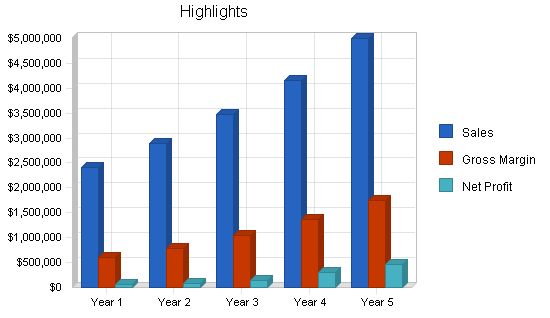
1.1 Objectives
– Maintain or exceed the recent two-year levels of sales ($2.5 million), gross margin (25%), and net margin (12%) in year 1.
– Realize a 20% annual sales growth rate in years 2-5, reaching over $5 million in sales by the end of year 5.
– Improve gross margins from 25% to 35% by the end of year 5.
– Improve net margins by the end of year 5.
– Redesign and upgrade the Internet e-commerce store within the first year.
– Increase website traffic by 50% and sales by 20% in years 1-5 through aggressive Web search optimization and marketing.
– Enhance the retail store location within the second half of year 1 by relocating to a more prime location in the metropolitan area.
– Establish relationships with local nonprofit organizations to help underprivileged children build confidence and self-esteem through youth sports programs.
– Run the business as a family-oriented company with emphasis on truth, integrity, quality relationships, fun, and community giving.
1.2 Mission
To become the sports equipment supplier of choice based on product expertise, price, quality, and level of service. Develop long-term relationships with customers and become the "family expert" for sporting goods equipment. Treat customers like friends and family and maintain an experienced, knowledgeable, and caring staff that can help customers make the right purchase. Serve individuals outfitting their family, as well as coaches, athletic directors, and league representatives supplying their teams.
1.3 Keys to Success
– Upgrade the website to be professional, user-friendly, and offer incentives, features, and promotions to draw customers back. Optimize for maximum search results.
– Relocate the retail store to a more densely populated, growing location.
– Negotiate optimal agreements with major suppliers to improve margins, hold down costs, and maximize inventory turnover.
– Implement a state-of-the-art, computerized inventory management system to improve turnover and tracking.
– Expand the product line to offer equipment for additional sports in demand during slow seasons.
– Create an outside sales team known for product expertise and top service to call on schools, leagues, and associations.
– Train employees on product features and provide family-oriented sales and customer support.
– Train a store manager to cover for and be the backup for the Owner/President.
– Advertise and market in areas where the target customer base can learn about the retail and internet stores.
– Build a reliable operations infrastructure to serve customers, prepare accurate billing and accounting, follow up on orders and shipping, manage the website, and maintain expenses and collection of accounts receivable.
– Be an active member of the community by participating in nonprofit activities and sponsoring local sports teams, leagues, and tournaments.
– Ensure daily management practices align with the values of The Sportsuchtig mission to develop and maintain a successful and growth-oriented business.
Sportsuchtig sells quality sporting goods equipment for the entire family, specializing in baseball and softball equipment, apparel, and accessories. The company established a retail store in 1986 and an Internet sports store in 1998. The company operates out of a 7,400 square foot facility, housing the retail store, call center, office, and product warehouse. Over the past 3 years, the company has averaged $2.5 million in sales with a gross margin of 25%. 52% of sales are generated by the website and 48% from the retail store.
The retail store is open Monday through Saturday from 9:00 am to 7:00 pm and closed on Sunday. Orders are retrieved four to six times daily, except on Sunday. The 800 call center number is staffed during retail store hours.
There are several growth opportunities for Sportsuchtig, including widening the product offerings, enhancing the website, optimizing search engine results, relocating the retail store, staffing a sales force, and implementing a consistent, integrated marketing plan.
2.1 Start-up Summary
The startup expenses include legal fees for the purchase of the business, accounting fees for business evaluation and due diligence, prepaid rent and insurance for the retail facility, and expenses related to the creation and production of the business plan.
The startup assets include the purchase of assets worth $1 million, with the majority being inventory. Current assets include furniture, fixtures, display cases, and accounts receivable. Long-term assets include computers, servers, printers, and software.
The starting cash of $50,000 is working capital to cover expenses for 2 months, initial marketing efforts, and as a contingency fund.
The purpose of this business plan is to secure a $700,000 conventional or SBA loan for the purchase of the business. The remainder of the purchase and startup costs ($300,000) will be financed through owner investment.
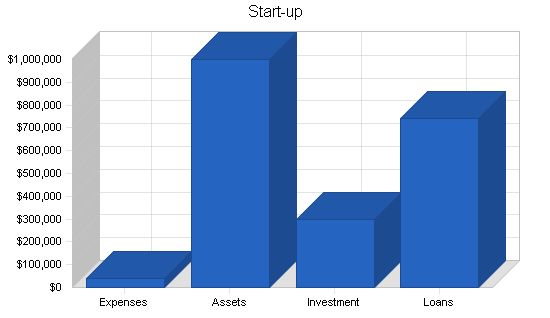
Start-up Requirements:
Start-up Expenses:
– Rent: $6,000
– Insurance: $2,000
– Legal Fees: $10,000
– Business Plan production: $100
– Accounting Fees: $1,000
– Business Plan Software: $200
– Loan Closing Costs: $20,000
– Other: $1,000
– Total Start-up Expenses: $40,300
Start-up Assets:
– Cash Required: $50,000
– Start-up Inventory: $900,000
– Other Current Assets: $25,000
– Long-term Assets: $25,000
– Total Assets: $1,000,000
Total Requirements: $1,040,300
Company Ownership:
The assets of Sportsuchtig are being purchased by John and Lisa Johnson. The company will be organized initially as a Limited Liability Corporation named Johnson Sporting Goods, LLC, doing business as Sportsuchtig.
Products:
Sportsuchtig will sell name-brand sporting goods, apparel, and accessories for the sports of baseball, softball, volleyball, basketball, and football, with a primary focus on softball and baseball. These products are purchased from manufacturers such as Easton, Louisville Slugger, Wilson, Worth, Mizuno, Miken, Under Armour, Jugs, Adams, ATEC, Playmaker, TrueSports, and Bike. Inventory is tracked through our POS cash register and computerized tracking system. The general list of products to be offered includes:
Baseball/Softball Equipment:
– Baseball Bats
– Baseball Gloves
– Batting Helmets
– Batting Tees
– Bases
– Catcher’s Equipment
– Bat Hangouts
– Batting Gloves
– Easy Toss Machine
– Instant Screens/Nets
– Hit-N-Stik
– Equipment Bags
– Hats
– Training Aides
– Sunglasses
– Baseballs
– Softballs
– Shoes/Cleats
– Umpire Equipment
– Ball Buckets
– Eye Black
– Scorebooks
– Pitching Machines
– Backstop/Batting Cages
– Ball Feeders
– Protective Screens
– Field Maintenance Equipment
– Ankle/Knee Braces
– Athletic Supporters
– Sliding Shorts
– Coaches’ Shorts
– Coaching/Training Aids & Videos
– Wraps
– Ice Packs
– First Aid
– Mouth/Lip Guards
– Protective Aids
Baseball/Softball Uniforms & Apparel:
– Uniforms for Men, Women and Youth
– Uniform Jerseys
– Uniform Pants
– Uniform Hats
– Socks
– Belts
– Custom screen printing of uniform names and numbers
– Under Armour Gear – Heat, Cold, All Season, Turf, Loose, Performance, and Street
– Manufacturer T-shirts and caps
Volleyball:
– Volleyballs
– Volleyball Bags
– Portable Scoreboard
– Knee Pads
– ClipBoard
– Volleyball Carts
Basketball:
– Basketball
– Basketball Systems/Hoops
– Basketball Courts
– Basketball Fencing
– Lighting Systems
Football:
– Footballs
– Shoulder Pads
– Knee Pads
– Thigh Pads
– Helmets
– Gloves
– WristCoach
Golf:
– Synthetic putting greens
Future Products:
After the assumption of the business, we will look to increase our product line laterally by offering additional product categories. Initially, this will be done to increase revenue in months that are historically slower for Sportsuchtig. We will also significantly grow the existing Volleyball, Basketball, and Football lines in year 1.
We will evaluate introducing products for the sports of Soccer, Field Hockey, Lacrosse, Hockey, Golf, Swimming, Tennis, Wrestling, Running, and Cheerleading. We will also evaluate the introduction of Major League and College sports team logo apparel such as NFL, NBA, MLB, NHL, NCAA, and NHL.
In addition, we will evaluate less vigorous and more relaxing sports lines such as camping, fishing, and golf to serve the older and more affluent sports participant.
Market Analysis Summary:
The sporting goods market is a multi-billion dollar industry, with retail sales reaching $45.8 billion in 2003. Sales are expected to grow 2% in 2004 to $46.7 billion. The personal consumption of sporting goods is forecast to grow at an annual compounded rate of 4.8% between 2004 and 2007. Retail sales at sporting goods stores are very sensitive to the health of the economy. Spending on sporting goods correlates strongly with consumer confidence and level of personal disposable income.
The sporting goods market can be categorized by product, sport, geography, behavior, participation, organization, and standard demographics. Demographics play a big part in sporting goods sales, as population growth and age groups distinctly impact sport participation.
Our main sales categories are based on Sports Participation. We will focus on players of Baseball, Softball, Volleyball, Basketball, and Football.
In terms of marketing, we will take different approaches to attracting the attention of potential customers based on their relation to the sport or sports player, and on their buying method/location.
Customer Type – These customers have needs based on the type of role they play in regards to the sports participants. These segments include: Individual Participants, Parents, League Representatives, Independent Team Coaches, School Athletic Coaches and Directors, and Sports Performance Businesses.
We believe that Sportsuchtig is well positioned to strategically attack these markets. We will first focus on increasing growth in the market segments we currently serve (baseball, softball) and then aggressively penetrate and increase sales to other sports participant segments, especially those that cater to the athletic tastes of aging baby boomers. We will initially look to increase our exposure and products to League Representatives and Independent Team Coaches in the metropolitan area. We will approach the 256 million participants nationwide through the internet store, which will be enhanced with an improved user experience and an aggressive Web marketing strategy.
Market Segmentation:
Sportsuchtig’ market is both nationwide via the internet store and local in the local metropolitan region. The targeted customer market will be segmented as follows:
Sports Participation – These customers have needs based on the specific sport(s) in which they participate. The major sports participation segments initially for Sportsuchtig are:
– Baseball
– Softball
– Volleyball
– Basketball
– Football
– Other Sports (Future for Sportsuchtig)
Customer Type – These customers have needs based on the type of role they play in regards to the sports participants. These segments include: Individual Participants, Parents, League Representatives, Independent Team Coaches, School Athletic Coaches and Directors, and Sports Performance Businesses.
Retail/Online – It is critical for us, as a retail store, to understand the demographics of our different sales bases. The demographic for the internet store is truly nationwide, while the local metropolitan area has its own unique demographic.
Overall, Sportsuchtig has great opportunities for growth in the different market segments.
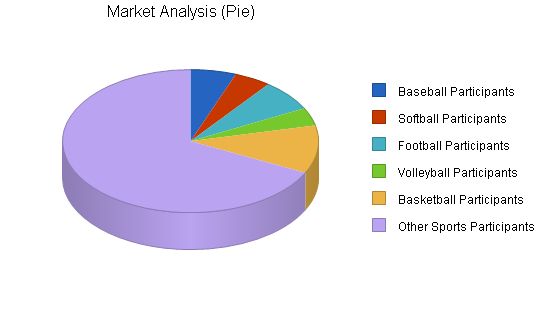
Market Analysis
| Market Analysis | |||||||
| Year 1 | Year 2 | Year 3 | Year 4 | Year 5 | |||
| Potential Customers | Growth | CAGR | |||||
| Baseball Participants | -1% | 14,600,000 | 14,454,000 | 14,309,460 | 14,166,365 | 14,024,701 | -1.00% |
| Softball Participants | -1% | 11,800,000 | 11,682,000 | 11,565,180 | 11,449,528 | 11,335,033 | -1.00% |
| Football Participants | 0% | 18,000,000 | 18,000,000 | 18,000,000 | 18,000,000 | 18,000,000 | 0.00% |
| Volleyball Participants | -1% | 10,400,000 | 10,296,000 | 10,193,040 | 10,091,110 | 9,990,199 | -1.00% |
| Basketball Participants | 1% | 27,900,000 | 28,179,000 | 28,460,790 | 28,745,398 | 29,032,852 | 1.00% |
| Other Sports Participants | 11% | 173,000,000 | 192,030,000 | 213,153,300 | 236,600,163 | 262,626,181 | 11.00% |
| Total | 7.78% | 255,700,000 | 274,641,000 | 295,681,770 | 319,052,564 | 345,008,966 | 7.78% |
4.2 Target Market Segment Strategy
The focus will initially be on the Baseball and Softball participant segment since Sportsuchtig has expertise in these areas and there is a large number of participants. We will leverage current relationships and aggressively increase sales through targeted marketing.
We will also strategically target other participation segments during non-peak baseball/softball sales months. This is a significant growth opportunity, reflecting the changing composition of the U.S. population. As the Baby Boomers age, they participate less in vigorous sports and more in relaxed sports. It is crucial to meet sales goals by quickly moving into at least one sport that serves this aging market.
The "customer type" segments are currently underserved by Sportsuchtig. Although the company has relationships with various leagues and organizations, there is room for significant segment penetration with targeted sales efforts and a sales team.
Due to the presence of both an internet and retail store, it is important to understand market segmentation and demographics on both a national and local level. Attacking the nationwide segment through a focused Web strategy could bring significant returns.
In the U.S., about 20,000 companies operate retail sporting goods stores, with combined annual revenue of $25 billion. Most operate a single retail location. Large chain operators include Sports Authority, Gart Sports, Dick’s Sporting Goods, and Hibbett Sporting Goods. The industry is highly fragmented, with the 20 largest chains holding only about 35 percent of the national market.
Sporting goods stores vary according to format and merchandise. Large format stores, also known as "Big Box" stores, are from 20,000 to 100,000 square feet and stock a large number of items. Traditional sporting goods’ retail stores are from 5,000 to 20,000 square feet and carry a more limited number of items. Sportsuchtig falls into this traditional format with 7,400 square feet, $2.5 million in sales, and 10-12 employees. Large format stores typically have more than $5 million in annual revenue and more than 50 employees. Traditional retail stores typically have $1-$5 million in sales and 10-50 employees. In the U.S., there are about 8,000 large-format and traditional sporting goods stores.
Sporting goods are also sold by mass merchandisers like Wal-Mart, Kmart, and Target, and by catalog and Internet retailers. Small local stores can compete by offering better service or specializing in a particular sport(s). Knowledgeable salespeople are a strong competitive factor. Marketing is typically through a combination of advertising and sports events. Many companies sponsor local sports events, host appearances by sports celebrities, and provide technical services and "participation areas." Inventory management is a major concern for all sporting goods retailers due to the large number of items they sell and the short selling season for many sports. Many companies use computerized inventory management systems.
4.3.1 Competition and Buying Patterns
Sportsuchtig’s retail store in the metropolitan area faces competition from one large format sporting goods chain with 4 locations, 2 traditional format sporting goods stores with 1 location each, and around 18 specialty sporting goods stores.
The large format store is Dick’s Sporting Goods, which operates 221 stores in 32 states. Dick’s offers a variety of sports equipment and products, but their selection within each sport is limited. Their stores appear to be understaffed, and their employees are not very knowledgeable. Products are generally priced higher than the competition.
The two traditional sporting goods stores in the metropolitan area are Don’s Sporting Goods and Happy Sports. These stores have been in the local market for over 30 years and offer a limited selection of sports products. Don’s specializes in distributing team uniforms and school equipment.
Play It Again Sports is a national franchise chain that buys, sells, and trades used and new sports equipment. They have 4 franchises in the local area but are poorly staffed and their prices are not much more competitive than Dick’s.
Specialty stores in the area specialize in specific sports. As Sportsuchtig expands into these sports, these stores will become direct competitors.
There are many Internet sports stores vying for online customers’ dollars. The most significant competitors include big box stores like Dick’s and The Sports Authority, as well as smaller traditional companies. Sportsuchtig’s internet store has performed well to date against this competition, and with an improved website design and marketing strategy, sales can be significantly increased.
Sportsuchtig believes its large selection, inventory, technical knowledge, and customer service will help compete against competitors in the local market.
Strategy and Implementation Summary
Sportsuchtig will leverage its expertise, product offerings, and marketing strategy to increase its customer base, drive sales, and generate profit.
5.1 Sales Strategy
Sportsuchtig will approach retail sales from a salesperson-customer relationship basis. All sales associates will be trained and encouraged to assist customers in a personal manner, utilizing first names and providing the desired services. Customer information will be gathered to target marketing efforts effectively, offer products that increase sales, develop services that enhance the shopping experience, and train employees.
The retail store will be reformatted to allow customers to touch and browse merchandise without requiring assistance from salespeople. The store will showcase products via lifestyle merchandising, creating a strong visual impact and invitation to purchase.
Sportsuchtig will attend sporting goods trade shows to stay up-to-date with products and gain fresh store merchandising ideas. Trade publications and associations will also be utilized to stay informed about market trends.
Pricing structure will support a 25-35% gross margin to remain competitive. Seasonal promotional offers, discounts, and sale events will encourage additional sales.
Employees will be trained and compensated fairly to provide excellent customer service. A sales team will be developed to actively pursue sales in the League, School, and Team market segments.
Web sales will be handled electronically via the internet store Shopping Cart or phone sales representatives. These representatives will be thoroughly trained and equipped with product knowledge.
By following these strategies, Sportsuchtig aims to increase sales and achieve steady growth over the next five years.
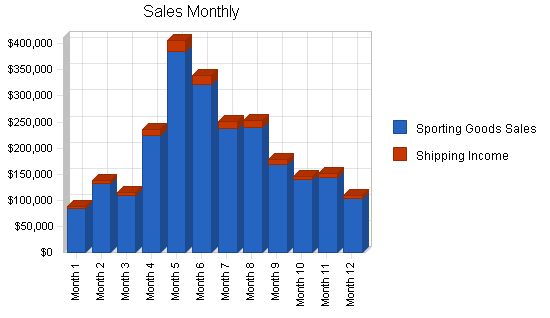
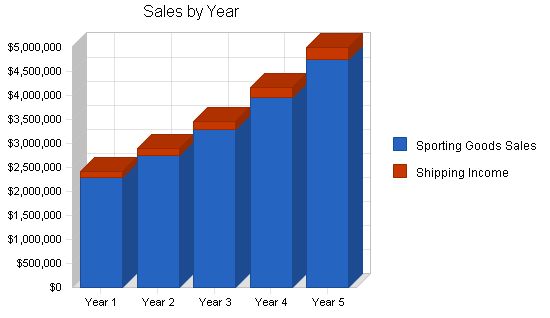
Sales Forecast
Sporting Goods Sales
– Year 1: $2,288,184
– Year 2: $2,745,821
– Year 3: $3,294,985
– Year 4: $3,953,982
– Year 5: $4,744,779
Shipping Income
– Year 1: $120,351
– Year 2: $144,421
– Year 3: $173,305
– Year 4: $207,966
– Year 5: $249,560
Total Sales
– Year 1: $2,408,535
– Year 2: $2,890,242
– Year 3: $3,468,290
– Year 4: $4,161,948
– Year 5: $4,994,339
Direct Cost of Sales
Cost of Goods Sold
– Year 1: $1,806,461
– Year 2: $2,109,877
– Year 3: $2,427,803
– Year 4: $2,788,505
– Year 5: $3,246,320
Other
– Year 1: $0
– Year 2: $0
– Year 3: $0
– Year 4: $0
– Year 5: $0
Subtotal Direct Cost of Sales
– Year 1: $1,806,461
– Year 2: $2,109,877
– Year 3: $2,427,803
– Year 4: $2,788,505
– Year 5: $3,246,320
Milestones
Initial Business Plan: 9/8/2004 – 9/19/2004
Letter of Intent: 9/17/2004 – 9/24/2004
Apply for Loan: 9/20/2004 – 9/24/2004
Contract to Purchase: 10/4/2004 – 10/22/2004
Lease Agreement: 10/4/2004 – 10/22/2004
Non-Compete Agreement: 10/4/2004 – 10/22/2004
Loan Authorization Obtained: 10/15/2004 – 6/6/2009
Secure Insurance – Business & Key Man: 10/25/2004 – 11/12/2004
Due Diligence: 10/25/2004 – 11/19/2004
Close Loan/Deal: 12/1/2004 – 12/1/2004
Begin Operation: 12/1/2004 – 12/1/2004
Owner Training Period: 12/1/2004 – 1/15/2005
Computer Systems Disaster Recovery Evaluation and Implementation: 12/1/2004 – 12/31/2004
Inventory System Review and Plan: 12/1/2004 – 12/31/2004
Implement Staff Uniform: 12/10/2004 – 12/20/2004
Retail Store Layout Modification Design: 1/2/2005 – 1/31/2005
Shipping & Receiving Process Review & Plan: 1/2/2005 – 1/31/2005
Accounting System Review & Plan: 1/2/2005 – 1/31/2005
Policy and Procedures Manual: 1/2/2005 – 2/28/2005
Hire or Promote Store Manager: 1/15/2005 – 2/15/2005
Business Plan Review: 1/15/2005 – 1/31/2005
Point-of-Sale System Review & Plan: 2/1/2005 – 2/28/2005
BNI Marketing: 2/1/2005 – 3/31/2005
Website Re-Design: 2/1/2005 – 2/28/2005
Hire Team Sales Manager: 2/1/2005 – 3/1/2005
Retail Store Format Change: 2/20/2005 – 2/21/2005
Begin Sunday Operation: 2/27/2005 – 2/27/2005
WEB Site Development & Implementation: 3/1/2005 – 6/1/2005
Determine League & Tournament Sponsorships for 2005: 3/1/2005 – 3/15/2005
Flyer Marketing to Leagues: 3/1/2005 – 4/15/2005
Flyer Marketing to Mailboxes: 3/1/2005 – 4/15/2005
Article in Times Dispatch about Business Purchase: 3/1/2005 – 3/31/2005
Team Sales – Sales Plan: 3/1/2005 – 3/31/2005
Identify New Fall Sport Segment(s): 3/1/2005 – 3/31/2005
Determine New Store Location: 3/1/2005 – 5/1/2005
Negotiate and Order New Sport Inventory: 4/1/2005 – 4/30/2005
Marketing Plan for New Product(s): 4/1/2005 – 4/30/2005
Employee Training Plans: 5/1/2005 – 5/31/2005
Supplier Agreements/Relationships Review & Plan: 5/1/2005 – 5/31/2005
Sign New Location Lease Agreement: 5/1/2005 – 5/15/2005
New Store Layout Design: 5/1/2005 – 6/1/2005
New Warehouse Design: 5/1/2005 – 6/1/2005
Inventory System Upgrade: 5/15/2005 – 6/15/2005
Employee Review Process: 6/1/2005 – 6/30/2005
New Location Buildout: 6/1/2005 – 7/31/2005
New Store Marketing Plan: 6/1/2005 – 7/15/2005
Website Live Deployment: 6/15/2005 – 6/15/2005
Web Marketing Plan Execution: 6/16/2005 – 12/31/2005
New Store Marketing Execution: 7/15/2005 – 12/31/2005
New Store Stock and Set-Up: 8/1/2005 – 8/12/2005
New Product(s) Marketing Plan Execution: 8/1/2005 – 12/31/2005
Store Move: 8/13/2005 – 8/14/2005
New Store Opening: 8/15/2005 – 8/15/2005
New Store Grand Opening: 8/20/2005 – 8/21/2005
Identify Non-Profit Partner: 10/1/2005 – 10/31/2005
Accounting System Upgrade: 11/1/2005 – 11/30/2005
Company Christmas Party: 12/15/2005 – 12/20/2005
Evaluate Discount Card Program: 1/2/2006 – 1/31/2006
Order Spring Inventory: 9/15/2009 – 11/1/2005
Totals: $119,800
Marketing Strategy
The marketing strategy of Sportsuchtig centers on defining our market niche in terms that benefit our customer. We will integrate and synchronize retail and internet store marketing. Our plan is to establish a consistent and coherent marketing plan and calendar that utilize all effective forms of publicity, advertising, and other marketing tools. Specific strategies include:
– Newspaper/Print Ads: We will run limited-space ads in local newspapers to keep our name and phone number in front of the consumer. Clip-out coupons may be offered as an incentive to visit the store and track revenue from the ads. Magazine print ads are not expected to have a significant return.
Hello!
I’m Andrew Brooks, a seasoned finance consultant from the USA and the mind behind phonenumber247.com.
My career is built on a foundation of helping individuals and businesses thrive financially in an ever-changing economic landscape. At phonenumber247.com, my aim is to demystify the complex world of finance, providing clear, actionable advice that can help you navigate your financial journey with confidence. Whether it’s personal finance management, investment strategies, or understanding the nuances of market dynamics, I’m here to share insights and tools that can propel you towards your financial goals.
Welcome to my digital space, where every piece of advice is a step closer to financial clarity and success!
